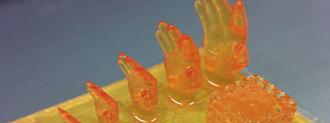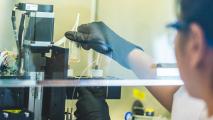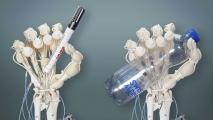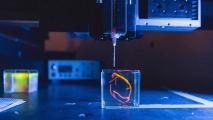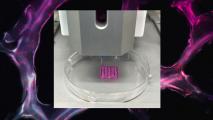Every day, 17 people die in the U.S. while waiting for an organ transplant — the supply of donated organs simply can’t meet the demand.
In the future, though, patients might not even have to put their names on a waiting list — their doctors might be able to use 3D printing technology to make a new organ for them.
Now, University at Buffalo researchers have found a way to overcome one hurdle on the path to 3D printed organs — slow print times — using light and hydrogels.
3D Printed Organs
Standard 3D printers build objects from the ground up in layers.
Using a computer model as a guide, the printer extrudes one layer of material — usually plastic — onto a plate. It then adds another layer on top of it, and this process repeats until the entire object is built.
When creating 3D printed organs, the plastic ink is replaced by one made of biological materials.
In 2019, for example, researchers demonstrated that they could 3D print a small replica of a human heart, using stem cells coaxed into developing into heart cells and blood vessels.
If the process could be scaled up, doctors could not only make an organ for any patient in need, they could make one out of the patient’s own cells, minimizing the chances of organ rejection.
Creating even mini organs takes a long time using today’s technologies, though, and that slow pace can affect both the quality of the 3D printed organs and the biological activity of the cells.
Bigger organs require longer print times, increasing the odds of a subpar finished product.
Hydrogels and Light
To move faster, the UB researchers developed a new technique for making 3D printed organs: fast hydrogel stereolithography printing (FLOAT).
Stereolithography is an existing 3D printing technique, in which light is shone into a vat of liquid resin. Wherever the light hits, the liquid cures.
They cut the print time for a mini model of a human hand from six hours to just 19 minutes.
By programming the light to move in a precise pattern, it’s possible to 3D print an intricately shaped object that can then be removed from the vat.
The FLOAT technique uses light to create objects out of hydrogels — these jelly-like materials, often used in diapers, can absorb large amounts of liquids.
Packing hydrogels with living cells, the researchers demonstrated FLOAT’s ability to print objects with vascular networks — including a tiny liver.
They also printed a tiny model of a human hand, which would’ve taken six hours using conventional 3D printing methods, in just 19 minutes.
According to the researchers, FLOAT can print objects at speeds up to 50 times faster than the industry standard — and that speed improved the quality of the 3D printing.
“(The technique) significantly reduces part deformation and cellular injuries caused by the prolonged exposure to the environmental stresses you commonly see in conventional 3D printing methods,” researcher Chi Zhou said in a press release.
So far, they’ve only made centimeter-sized objects using the technique, but they plan to scale it up to larger objects. If it can be done, it could help usher in an era where everyone who needs a new organ gets one.
Editor’s Note, 3/15/21. 11:20 EST: This article was updated to clarify the technique used to make the 3D printed organs.
We’d love to hear from you! If you have a comment about this article or if you have a tip for a future Freethink story, please email us at [email protected].
